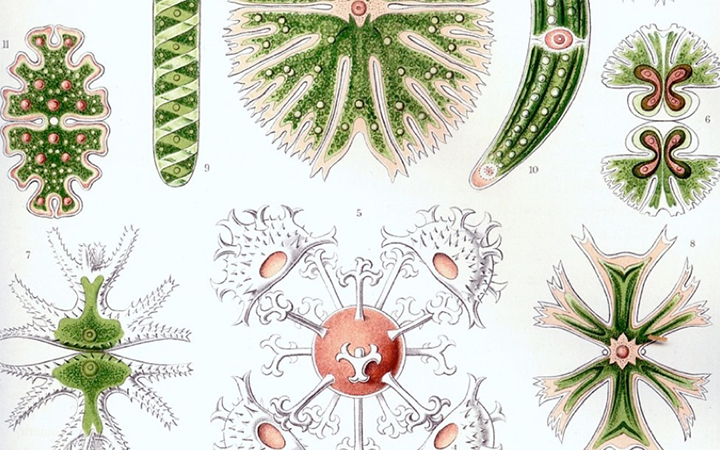Desmids (Gr. desmos, bond or chain) are an order (Desmidiales) in the Charophyta, a division of green algae that forms a sister group to the land plants (Embryophyta).[1] The desmids are often treated as members of the Zygnematales, as family Desmidiaceae.[2][3] The Desmidiales comprise around 40 genera and 5,000[4] to 6,000[5] species, found mostly but not exclusively in fresh water. Many species may be found in the fissures between patches of sphagnum moss in marshes. With a pH level of approximately 4.0, sphagnum peat provides the ideal environment for this flora. The structure of these algae are unicellular, while the cell is sometimes divided into two symmetricalcompartments separated by a narrow bridge or isthmus, wherein the spherical nucleus is located. Each semi-cell houses a large, often folded chloroplast for photosynthesizing. One or morepyrenoids can be found. These form carbohydrates for energy storage. Desmids assume a variety of highly symmetrical and generally attractive shapes, among those elongated, star-shaped and rotund configurations, which provide the basis for their classification.[6] The largest among them may be visible to the unaided eye.[7] Desmidiales lack in flagellae. Desmids commonly reproduceby asexual fission, however, in adverse conditions, Desmidiales may reproduce sexually through a process of conjugation,[8][9] which are also found among the Zygnematales. These two groups are closely related, and comprise the class Zygnematophyceae. They resemble the algae genusSpirogyra as some of them are filamentous, such as the species Desmidium swartzii. However, these filaments are arranged in a helix pattern.[6]
Desmids possess characteristic crystals of Barium sulphate at either end of the cell[10] which exhibit a continuous Brownian type motion.
Many desmids also secrete translucent, gelatinous mucilage from pores in the cell wall that acts a protecting agent.
(From Wikipedia, March 2015)




